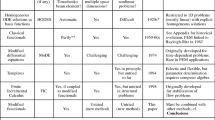Abstract
It has been shown in a recent work [1] that the elastic T-term at the tip of a mixed mode crack can be determined by the so-called second order weight functions through a work-conjugate integral that is akin to that of the Bueckner-Rice weight function method for evaluating stress intensity factors. In this paper, the development of the second order weight functions is reviewed. These second order weight functions are determined using a unified finite element method introduced in [2]. The finite element procedure handles both traction and displacement boundaries and it permits the Bueckner-Rice weight functions and the second order weight functions for the elastic T-term to be determined in one single finite element run. The accuracy of the computed weight functions is assessed by comparing the computed results with special closed form solutions. The numerical values of the elastic T-term for single edge notch specimens under tension, pure bending and three-point bend are given. The corresponding second order weight functions are tabulated.
Similar content being viewed by others
References
T.-L. Sham, International Journal of Solids and Structures 25 (1989) 357–380.
T.-L. Sham, International Journal of Solids and Structures 23 (1987) 1357–1372.
N.I. Muskhelishvili, Some Basic Problems of the Mathematical Theory of Elasticity, translated by J.R.M. Radok, Noordhoff, Leyden (1977).
H.F. Bueckner, in Mechanics of Fracture I: Methods of Analysis and Solution of Crack Problems, G.C. Sih (ed.), Noordhoff, Leyden (1973) 239–314.
M.L. Williams, Journal of Applied Mechanics 24 (1957) 109–114.
S.G. Larsson and A.J. Carlsson, Journal of the Mechanics and Physics of Solids 21 (1973) 263–277.
J.R. Rice, Journal of the Mechanics and Physics of Solids 22 (1974) 17–26.
B.A. Bilby, G.E. Cardew, M.R. Goldthorpe and I.C. Howard, in Size Effects in Fracture, Mechanical Engineering Publications Limited, London (1986) 37–46.
B. Cotterell and J.R. Rice, International Journal of Fracture 16 (1980) 155–169.
P.S. Leevers and J.C. Radon, International Journal of Fracture 18 (1982) 311–325.
A.P. Kfouri, International Journal of Fracture 30 (1986) 301–315.
H.F. Bueckner, Zeitschrift fur Angewandte Mathematic und Mechanik 50 (1970) 529–533.
J.R. Rice, International Journal of Solids and Structures 8 (1972) 751–758.
T.-L. Sham, Engineering Fracture Mechanics 31 (1988) 567–576.
T.-L. Sham and Y. Zhou, Engineering Analysis and Boundary Elements 6 (1989) 38–47.
H. Tada, P. Paris and G. Irwin, The Stress Analysis of Cracks Handbook, Del Research Corporation, Hellertown (1973).
T.-L. Sham, Tables of weight functions for fracture specimens, Technical Report No. CML-89–1, Department of Mechanical Engineering, Rensselaer Polytechnic Institute, Troy (1989).
Author information
Authors and Affiliations
Rights and permissions
About this article
Cite this article
Sham, T.L. The determination of the elastic T-term using higher order weight functions. Int J Fract 48, 81–102 (1991). https://doi.org/10.1007/BF00018392
Received:
Accepted:
Issue Date:
DOI: https://doi.org/10.1007/BF00018392




